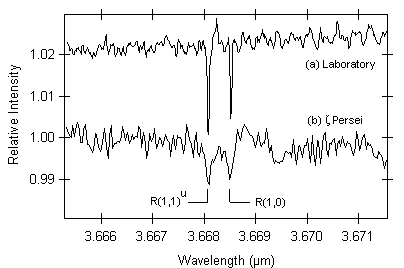OBSERVATIONAL PROJECTS - BERKELEY
H3+ towards Zeta Persei and a High Cosmic-Ray Flux
Our discovery of H3+ in diffuse clouds (more details), where CO is not the dominant reservoir of carbon, has suggested that the models of H3+ chemistry are using an incorrect value for one of three key parameters: the dissociative recombination rate constant, the electron fraction, or the cosmic-ray ionization rate. To make sense of the observed H3+ column densities, one or more of these values must be changed by almost two orders of magnitude! Our recent storage-ring measurements of H3+ dissociative recombination (more details) suggest that this value is not the source of the problem. This leaves the next most likely suspect as the electron fraction: until recently, we had not been able to detect H3+ in a sightline with sufficient UV flux to enable spectroscopy of H2 and C+ (the source of the electrons).
 In 2002, using the CGS4 spectrometer at UKIRT, we managed to detect weak
absorption lines of H3+ along the line of sight to
zeta Persei, a classical and well-studied diffuse cloud source. This
star is bright enough that the H2 column density had long ago
been measured by Copernicus, and the C+ column density had also
been measured by Hubble Space Telescope. Significantly, the electron
fraction in this sightline has exactly the same value as had been used in
the models of H3+ chemistry...thus ruling out the
electron fraction as the cause of the overabundant H3+.
In 2002, using the CGS4 spectrometer at UKIRT, we managed to detect weak
absorption lines of H3+ along the line of sight to
zeta Persei, a classical and well-studied diffuse cloud source. This
star is bright enough that the H2 column density had long ago
been measured by Copernicus, and the C+ column density had also
been measured by Hubble Space Telescope. Significantly, the electron
fraction in this sightline has exactly the same value as had been used in
the models of H3+ chemistry...thus ruling out the
electron fraction as the cause of the overabundant H3+.
The combination of these results appears to leave the cosmic-ray ionization rate as the culprit: we suggest that, at least in the cloud towards zeta Persei, the cosmic-ray ionization rate must be a factor of 40 times higher than the canonical value in dense clouds. The fact that we have observed H3+ in many diffuse cloud sightlines suggests that zeta Persei is unlikely to be an unusual case, and that there may be a significant flux of low-energy cosmic rays that have sufficient energy to permeate diffuse, but not dense, clouds. Searches for H3+ in more UV-accessible sightlines continue using CGS4 at UKIRT and NIRSPEC at Keck.
Reference:
|
B. J. McCall, A. J. Huneycutt, R. J. Saykally, T. R. Geballe,
N. Djuric, G. H. Dunn, J. Semaniak, O. Novotny, A. Al-Khalili,
A. Ehlerding, F. Hellberg, S. Kalhori, A. Neau, R. Thomas,
F. Osterdahl, and M. Larsson
Enhanced cosmic-ray flux toward zeta Persei inferred from laboratory study of H3+-e- recombination rate Nature, 422, 500 (2003) |
LINK
|
|
|
|
|